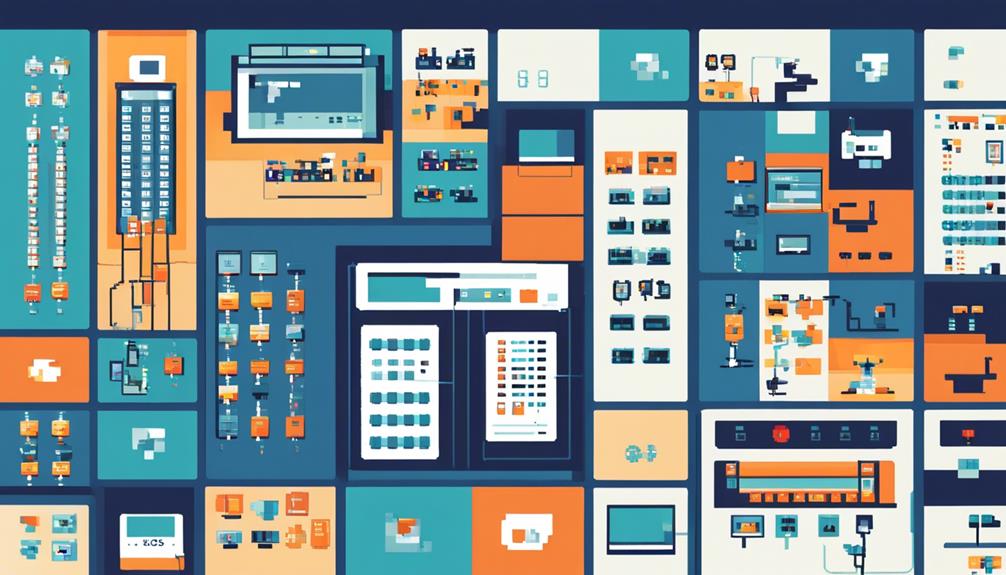In today's fast-paced business environment, effective communication is essential for success. As technology continues to evolve, so does the way we communicate within organizations.
One area that has seen significant advancements is PBX (Private Branch Exchange) technology. From its early beginnings as a manual switchboard system to the introduction of digital PBX and the integration of VoIP (Voice over Internet Protocol) and unified communications, PBX technology has come a long way.
But the story doesn't end there. In this discussion, we will explore the evolution of PBX technology, highlighting key milestones and future trends that promise to shape the way businesses communicate.
So, let's delve into the fascinating world of PBX technology and discover the possibilities it holds for the future of business communication.
Key Takeaways
- PBX technology has evolved from early systems to digital PBX, offering numerous advantages such as improved call quality, scalability, and cost savings.
- VoIP PBX systems provide additional benefits like cost savings, user-friendly control panels, and the ability to work remotely.
- VoIP technology has enhanced communication efficiency by allowing phone calls over the internet, offering advanced features, and enabling easy management.
- Advancements in PBX features have led to enhanced call routing, integrated communication channels, improved efficiency and productivity, and a better customer experience.
Early PBX Systems

Early PBX systems revolutionized business communication by allowing companies to efficiently share a limited number of phone lines across multiple phones. Before the advent of PBX systems, businesses had to rely on individual public telephone lines for each phone, which was costly and inefficient. With PBX systems, a centralized switching unit was installed on the company premises, enabling calls to be routed internally without the need for external telephone lines.
The first PBX systems were manually operated, requiring an operator to physically connect calls by plugging and unplugging cables. However, as technology advanced, PBX systems incorporated automatic call routing and electronic switching technologies. This automation significantly improved the efficiency and capabilities of PBX systems, allowing for faster call connections and reducing the reliance on human operators.
One major advancement in PBX technology was the introduction of Time Division Multiplexing (TDM) in the late 1960s. TDM enabled multiple phone calls to be transmitted over a single physical line by dividing the line's capacity into time slots. This breakthrough technology greatly increased the efficiency of PBX systems, allowing for more simultaneous calls to be made and received.
In 1997, the integration of Internet Protocol (IP) with PBX systems led to the development of IP PBX. This innovation allowed for the transmission of voice calls over the internet, providing virtual hosting and paving the way for unified communications. IP PBX systems offered businesses the ability to integrate their phone systems with other communication channels, such as email and instant messaging, enhancing overall communication efficiency.
Hybrid PBX systems emerged as a cost-saving upgrade option for businesses that wanted to incorporate IP technology while still utilizing their existing TDM-based hardware. These systems allowed for a seamless transition to IP-based communication by integrating IP capabilities with traditional PBX infrastructure.
Transition to Digital PBX
The transition to digital PBX systems marks a significant advancement in business communication technology, offering improved call quality, enhanced features, and increased flexibility for organizations. Digital PBX systems leverage new technologies such as Voice over IP (VoIP) to transmit voice calls over the internet, resulting in clearer and more reliable connections compared to traditional analog systems. These systems also introduce a wide range of features, including call forwarding, voicemail, and conference calling, which greatly enhance communication capabilities within businesses.
Digital PBX systems provide organizations with more flexible call routing options and scalability. With digital systems, calls can be easily routed to different departments or individuals based on specific criteria, such as time of day or caller ID. This flexibility allows businesses to handle larger call volumes more efficiently, boosting productivity and customer satisfaction. Additionally, digital PBX systems can easily integrate with other communication tools, such as email and instant messaging, to enable seamless collaboration and improve overall efficiency within organizations.
The evolution of digital PBX has led to the emergence of IP PBX systems, which further enhance the capabilities of business communication. IP PBX systems leverage Internet Protocol (IP) technology to transmit voice calls, enabling even greater flexibility in call routing and integration with communication and collaboration tools. These systems also support unified communication features, such as video conferencing and presence information, which streamline communication and promote collaboration among employees.
In summary, the transition to digital PBX systems has revolutionized business communication by offering improved call quality, enhanced features, and increased flexibility. With the advent of IP PBX systems, organizations can further leverage new technologies to optimize their communication processes and foster collaboration. As digital PBX systems continue to evolve, businesses can expect even more customizable solutions that cater to their specific needs, while remaining cost-effective and scalable.
| Advantages of Digital PBX Systems | |
|---|---|
| Improved call quality | |
| Enhanced features (call forwarding, conference calling, etc.) | |
| Flexible call routing and scalability | |
| Integration with other communication tools |
Introduction of VoIP in PBX Technology

The introduction of VoIP in PBX technology has revolutionized traditional communication systems by offering numerous benefits.
VoIP technology enables phone calls over the internet, converting analog voice into digital packets for more efficient and cost-effective communication.
With VoIP, businesses can experience enhanced communication efficiency, cost savings, and advanced features that were previously unavailable with traditional PBX systems.
VoIP Benefits for PBX
VoIP technology has revolutionized the functionality and efficiency of PBX systems, offering numerous benefits that enhance communication and streamline business operations.
With VoIP PBX, businesses can enjoy cost savings as it eliminates the need for separate phone lines and reduces maintenance and training charges.
The user-friendly control panel of VoIP PBX allows for easy management, enabling businesses to make changes and configure settings effortlessly.
Additionally, VoIP PBX systems provide advanced features like auto attendants and call recording, enhancing the overall business communications experience.
Hosted PBX systems further enhance flexibility by enabling remote work and seamless integration with mobile devices.
As a recommended provider in the UK, VoIP Business offers cost-effective and reliable services, allowing businesses to leverage the benefits of VoIP in their PBX technology.
Enhancing Communication Efficiency
Introduction of Voice over Internet Protocol (VoIP) technology in PBX systems has significantly enhanced communication efficiency, revolutionizing the way businesses handle their phone calls. By leveraging the power of the internet, VoIP allows for phone calls over the internet, eliminating the need for traditional telephone lines. This has led to several benefits for businesses:
- Cost savings: VoIP PBX systems eliminate the need for separate telephone lines, reducing monthly expenses.
- Advanced features: Cloud-based VoIP PBX systems offer features like auto attendants and call recording, enhancing communication capabilities.
- Scalability and flexibility: Hosted PBX in the cloud-based environment provides easy growth and flexibility, enabling businesses to adapt to changing communication needs.
- Improved productivity: With VoIP PBX, businesses can seamlessly integrate communication channels, such as voice, video, and messaging, leading to enhanced productivity and collaboration.
The introduction of VoIP technology in PBX systems has transformed communication in businesses, providing a more efficient and cost-effective solution for handling telephone calls.
Cost Savings With Voip
With the introduction of Voice over Internet Protocol (VoIP) technology in PBX systems, businesses have experienced significant cost savings while enhancing their communication capabilities. VoIP PBX leverages internet-based calls, eliminating the need for traditional landline systems and reducing costs associated with hardware investments and ongoing maintenance. This evolution in PBX technology has revolutionized the way businesses communicate, offering cost-effective and flexible solutions. Hosted telephony systems, enabled by VoIP technology, provide businesses with scalability and advanced communication options without hardware limitations. Additionally, VoIP PBX systems offer advanced features like auto attendants and call recording, further enhancing communication capabilities while reducing expenses. The table below highlights the key cost savings businesses can achieve with VoIP PBX technology:
| Cost Savings With VoIP PBX |
|---|
| Reduced hardware costs |
| Lower maintenance expenses |
| Elimination of landline fees |
| Scalability and flexibility |
| Advanced communication features |
Advancements in PBX Features

Advancements in PBX features have revolutionized the way businesses handle their communication needs.
One notable advancement is enhanced call routing, which allows calls to be directed to the most appropriate destination based on predefined criteria.
Additionally, integrated communication channels provide seamless connectivity between various platforms, enabling users to access voicemails, emails, and other forms of communication in a centralized system.
These advancements not only improve efficiency and productivity but also enhance the overall customer experience.
Enhanced Call Routing
Enhanced Call Routing in PBX technology has revolutionized the way businesses handle and route calls, providing advanced features and criteria-based routing for efficient communication management.
Here are four key advancements in Enhanced Call Routing:
- Predefined Criteria: Enhanced Call Routing allows businesses to define specific criteria for call routing, such as time of day, location, or caller ID. This ensures that calls are directed to the appropriate individuals or departments.
- Auto Attendants and IVR: Advancements in PBX features have integrated auto attendants and interactive voice response (IVR) systems, enabling more efficient call routing and handling. Callers can navigate through menu options to reach their desired destination.
- Complex Call Flows: Enhanced Call Routing enables businesses to create complex call flows, ensuring calls reach the right destination efficiently. This flexibility improves communication and collaboration within the organization.
- Integration with Mobile Devices and Remote Workers: Enhanced Call Routing facilitates the integration of mobile devices and remote workers into the call routing process. This allows for improved communication flexibility and ensures that calls can be efficiently routed to employees regardless of their location.
With these advancements, Enhanced Call Routing has become an essential component of modern PBX technology, enabling businesses to streamline their telephone systems and enhance communication and collaboration through Unified Communications and VoIP technologies.
Integrated Communication Channels
Integrated Communication Channels have become a vital component of modern PBX technology, enabling businesses to seamlessly connect voice, video, and messaging for enhanced connectivity and collaboration.
In the past, the first PBX systems, also known as Private Branch Exchange (PBX), primarily focused on providing voice communication within an organization. However, with the advent of Internet Protocol (VoIP), PBX systems allowed businesses to integrate different communication channels into a single platform. This advancement eliminated the need for separate phone systems and allowed users to make calls, send messages, and conduct video conferences using a single device.
Traditional PBX systems were limited to voice communication, but the integration of various communication channels in modern PBX systems has revolutionized the way businesses communicate and collaborate.
Integration of Unified Communications
The consolidation of various communication methods into a single platform, known as Unified Communications integration, revolutionizes the way businesses connect and collaborate. This integration allows for the seamless consolidation of voice, video, and messaging into a unified platform, enabling employees to access all communication tools in one place.
Here are four key benefits of integrating Unified Communications:
- Enhanced Productivity: With Unified Communications integration, employees can communicate and collaborate more efficiently. They can access all communication channels from a single platform, eliminating the need to switch between different applications. This streamlines communication processes and reduces response times, ultimately improving productivity.
- Cohesive User Experience: Unified Communications integration provides a cohesive user experience across different devices and channels. Whether employees are working from their desktops, laptops, or mobile devices, they can easily access and manage their communication tools. This seamless experience enhances user satisfaction and engagement.
- Advanced Features: Integration of Unified Communications offers advanced features such as presence, voicemail to email, and video conferencing. These features enhance overall business communication by providing real-time presence information, enabling voicemails to be received as emails, and facilitating face-to-face communication regardless of location.
- Scalability and Flexibility: Unified Communications integration can be implemented through a VoIP system or a cloud-based PBX. This makes it easier for businesses to scale their communication infrastructure and adapt to changing needs. With a cloud-based solution, businesses can also benefit from cost savings and increased flexibility.
Cloud-Based PBX Solutions

Unified Communications integration has paved the way for the adoption of cloud-based PBX solutions, revolutionizing the way businesses manage their communication infrastructure. Cloud-based PBX solutions operate over the internet, eliminating the need for physical on-site infrastructure. These solutions are managed and hosted off-site by a service provider, reducing maintenance charges and offering advanced features like auto attendants and call recording. The flexibility and scalability of cloud-based PBX systems allow them to work with mobile devices and offer advanced business communication without hardware limitations.
One renowned provider in the UK, VoIP Business, offers cost-effective, flexible, and reliable cloud-based PBX services. Their services include VoIP phones, call conferencing, and call recording. With cloud-based PBX solutions, businesses can enjoy reduced costs as they no longer need to invest in expensive hardware and equipment. Instead, they can leverage their existing internet connection to access a wide range of features and functionalities.
To paint a clearer picture, here is a table showcasing the advantages of cloud-based PBX solutions:
| Advantages of Cloud-Based PBX Solutions |
|---|
| Eliminates the need for physical on-site infrastructure |
| Hosted off-site by a service provider, reducing maintenance charges |
| Offers advanced features like auto attendants and call recording |
| Works with mobile devices, providing flexibility and scalability |
| Reduces costs by leveraging existing internet connection |
The BYOC (Bring Your Own Carrier) model in cloud-based PBX systems provides further customization and flexibility for enterprises. With this model, businesses can have control over dialing plans, phone numbers, and call-routing solutions. This enables them to tailor their communication system to their specific needs and seamlessly integrate it into their existing workflows.
Mobile Compatibility in PBX Systems
How does mobile compatibility enhance the functionality and flexibility of PBX systems?
- Seamless Integration: Mobile compatibility in PBX systems allows users to make and receive phone calls using their mobile devices, ensuring seamless integration between mobile phones and the PBX system. This integration enables employees to stay connected and communicate effectively regardless of their location.
- Remote Work: With mobile compatibility, employees have the freedom to work remotely without sacrificing communication capabilities. They can access PBX features, such as call forwarding and voicemail, on their mobile devices, ensuring that they remain connected to the business even when they are away from the office.
- Enhanced Productivity: Mobile compatibility enhances productivity by ensuring that employees never miss important calls, even when they are on the go. With the ability to receive and make calls using their mobile devices, employees can stay connected with clients and colleagues, enabling them to provide timely responses and maintain productivity.
- Meeting Specific Needs: Mobile compatibility in PBX systems caters to the specific needs of modern businesses. It allows for greater flexibility in communication, accommodating the growing trend of remote work and the need for instant communication. By providing mobile compatibility, PBX systems have evolved to meet the changing demands of businesses and their employees.
Future Trends in PBX Technology

Mobile compatibility in PBX systems has paved the way for future trends in PBX technology, revolutionizing the way businesses communicate and setting the stage for advancements in artificial intelligence, 5G integration, cloud-based solutions, unified communications, and hybrid deployments.
Artificial intelligence (AI) and machine learning (ML) are expected to play a significant role in the future of PBX systems. AI-powered call routing algorithms can intelligently direct incoming calls to the most appropriate department or agent based on the caller's history or preferences. ML algorithms can analyze call data to identify patterns and trends, enabling businesses to make data-driven decisions and improve customer interactions.
The adoption of 5G technology will bring about significant improvements in PBX systems. With faster data speeds and lower latency, businesses will experience seamless communication and enhanced mobility. 5G integration in PBX systems will enable employees to make and receive calls without relying on traditional phone lines, providing greater flexibility and mobility for remote workers.
Cloud-based PBX solutions will continue to dominate the market due to their scalability, flexibility, and cost-effectiveness. By moving their PBX systems to the cloud, businesses can easily add or remove extensions, scale up or down based on demand, and access advanced features without the need for expensive PBX hardware.
The convergence of PBX systems with unified communications (UC) and collaboration tools will result in more integrated and streamlined communication experiences. UC platforms, such as video conferencing, instant messaging, and file sharing, can be seamlessly integrated into PBX systems, enabling employees to communicate and collaborate more efficiently.
Hybrid PBX deployments, which combine on-premises hardware with cloud-based features, will provide organizations with a balanced approach. This allows them to meet specific communication needs, such as maintaining control over sensitive data while benefiting from the scalability and flexibility offered by cloud-based solutions.
Frequently Asked Questions
What Is a Traditional Pbx?
A traditional PBX, or Private Branch Exchange, is a telephone system that operates within a building or company. It consists of various components such as telephones, telephone lines, and a control unit.
Traditional PBX systems offer benefits such as reliability, security, and control over call routing. However, they require substantial investment and ongoing maintenance.
Despite lacking advanced features provided by modern alternatives, traditional PBX systems continue to be used in some businesses.
Future prospects for traditional PBX technology may involve hybrid or cloud-based systems.
What Is the Basic of PBX Technology?
The basic of PBX technology lies in its ability to facilitate internal and external communication within an organization. PBX systems serve as a central hub, connecting multiple phone lines and extensions, and providing features such as call routing, voicemail, and conferencing.
The advantages of PBX technology include improved efficiency, cost savings, and enhanced call management. Implementation of PBX systems can be tailored to meet specific business needs.
Future trends in PBX technology include integration with other communication channels and advanced analytics capabilities. Case studies demonstrate the benefits of PBX technology in various industries.
What Replaced Pbx?
VoIP technology has largely replaced traditional PBX systems for business telephony. Cloud-based phone systems have emerged as a popular alternative, offering scalability and advanced features. This shift has been driven by the impact of mobile devices on traditional PBX systems, as businesses increasingly require flexibility and mobility in their communication solutions.
Hosted PBX solutions have also gained traction, providing businesses with cost-effective and flexible communication options. Additionally, the role of artificial intelligence and virtual PBX systems has revolutionized business communication, allowing for more efficient and personalized interactions.
Is PBX Outdated?
PBX technology is not outdated, but it has evolved with the introduction of cloud-based alternatives such as VoIP. The future of communication lies in these cloud-based solutions, which offer benefits such as cost-effectiveness, scalability, and flexibility for remote work.
VoIP has had a significant impact on PBX, allowing for integration with unified communications and offering advanced features. Hosted PBX, in particular, provides a reliable and customizable solution for businesses.
When comparing PBX and IP PBX, it is essential to consider factors such as cost, maintenance, and scalability to determine which is better suited for specific business needs.

